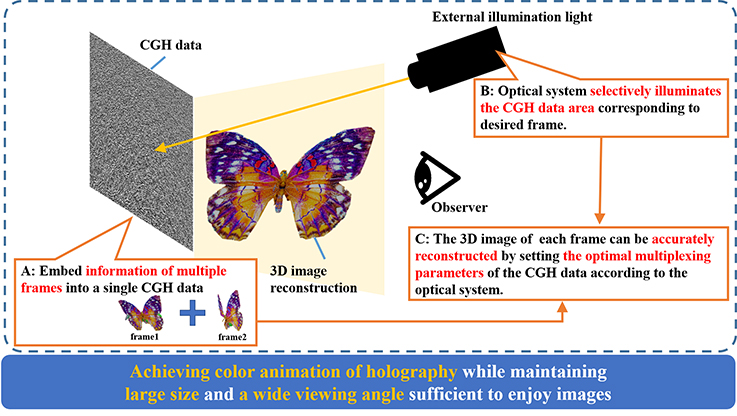Recent News Article
Achieving color animation of holography while maintaining large size and a wide viewing angle
The following is the text of the joint press release announced by Kansai University and KDDI Research, Inc. on May 9, 2022.
Achieving color animation of holography while maintaining large size and a wide viewing angle
-Realization of keenly anticipated media experiences in the Beyond 5G/6G era-
KDDI Research, Inc. (head office at Fujimino-shi, Saitama; Hajime Nakamura, Chief Executive Officer) and Professor Kyoji Matsushima at Kansai University have developed a new technology for holography, a 3D display technology that records and reproduces light waves. It multiplexes and embeds information of multiple frames into a single printed data and reconstructs 3D images.
This advance solves the problems of conventional holography technologies, which are limited to static reconstructed 3D images in order to realize large size and a wide viewing angle. We have achieved color animation of holography while maintaining large size (18cm x 18cm) (*1) and a wide viewing angle (30 degrees both horizontally and vertically) (*2) that makes viewing these images satisfying and enjoyable.
This technology expands the range of expression in holography and contributes to the realization of media experiences that are already being keenly anticipated in the Beyond 5G/6G era, such as highly realistic and more attractive video advertisements using 3D digital signage.
Fig.1 Optical reconstruction of our technology (butterfly)
Background
Because holography can record all light-related information including the intensity, color, and phase, and realizes a 3D image display that gives the impression of seeing a real object, it is said to be the ultimate 3D display technology. It has features that lessen the burden placed on the human body, such as eye and brain fatigue, and can be viewed simultaneously by many people.
Recently, many opportunities have been created to experience images through smartphones, tablets, and digital signage in the city. However, these are 2D displays and do not provide the same immersive and life-like impression as real space. In addition, the 3D display technologies in wide use today (*3) are not suitable for daily use because of the stress on the human eye and brain, and the limited number of observers who can see the image at the same time. In order to realize a more natural and realistic visual experience free from physical discomfort, there is an expectation for holography to become more amenable to practical use. In particular, computer-generated holograms (CGHs), which are created by holography techniques using a computer (computer holography), have been widely studied.
Although CGH realizes natural 3D images, it requires a high pixel density to expand the viewing angle. As a result, the screen size and viewing angle needed to comfortably enjoy 3D images would require an enormous number of pixels, more than 500 times the number required for 8K video. Therefore, previous studies have adopted the approach of printing CGH data using microfabrication techniques, of which full-parallax high-definition CGH (FPHD-CGH) (*4) is a representative example. This approach is being researched and developed by Kansai University, and currently it is limited to displaying static 3D images.
Achievements
KDDI Research and Kansai University have jointly advanced FPHD-CGH and have developed a technology that multiplexes and embeds information of multiple frames into a single CGH data and reconstructs 3D animations without increasing the number of pixels that need to be printed. As a result, we have succeeded in realizing color animations, as well as achieving both large size (18cm × 18cm) and a wide viewing angle (30 degrees) that makes viewing these images satisfying and enjoyable.
Optical 3D image reconstruction of CGH requires the CGH data displayed on the screen to be illuminated externally. Our technology spatially multiplexes the information of the wavelength of each RGB color (the three primary colors) for multiple frames into a single piece of CGH data to be printed, and also illuminates the CGH data area corresponding to each frame precisely. Specifically, by optimizing parameters for multiplexing, such as the area occupied by the CGH for each wavelength, according to the resolution and other characteristics of the optical system for illumination, we have made it possible to illuminate only the CGH data area corresponding to the target frame with sub-millimeter accuracy.
These advances have made it possible to accurately reconstruct each frame using a single piece of CGH data, and we have overcome the problem of FPHD-CGH, which is limited to reconstructing only static images (Fig. 2).
By utilizing this breakthrough, it is expected that CGH will be used in a wider range of applications in the future, such as switching the display of 3D guide signs and displaying animation in 3D digital signage.

Fig.2 Outline of our technology
Future vision
KDDI Research and Kansai University will further improve the image quality and the size of the color-animated CGH and establish the basic technology for the practical application of holography.
KDDI Research will also evaluate the acceptability of this technology for various applications such as digital signage and remote communication, and promote further research on cross reality (XR) technology with the objective of realizing immersive media experiences using holography, which is eagerly sought in the fields of media industry, advertising, and social media content after 2030.
■KDDI Research's Initiatives
KDDI and KDDI Research formulated "KDDI Accelerate 5.0", based on a concept for the next-generation society envisioned for 2030, and summarized how it can be accomplished in the "Beyond 5G/6G Whitepaper" in terms of the "Future Image" and "Technologies" required to create an ecosystem that spurs innovation. To develop a new lifestyle, the two companies will continue to invest in R&D on seven different technologies and on an orchestration technology that links them together. The results presented in this study correspond to one of the seven technologies, "XR".
■Kansai University's Initiatives
FPHD-CGH is a technology that creates images with a deep depth, something which is difficult to achieve with other 3D display technologies, enabling innovative signage and media experiences. However, this technology requires advanced computation and fabrication techniques, such as computing images with more than 100 billion pixels and displaying images with a pixel pitch of less than a micrometer. Kansai University has been developing and researching this technology for 20 years under the leadership of Professor Kyoji Matsushima in the Faculty of System Engineering, Department of Electrical, Electronic and Information Engineering.
Kansai University is not only developing this technology, but also releasing the software library necessary for the calculations and providing the fabrication technology, and aims to implement computer holography technology, a field where Japan is the world leader, in society, through an industry-academia collaboration.
(*1) Here, "postcard size (10cm x 14.8cm)" or larger is considered to be the screen size that allows images to be properly enjoyed.
(*2) A sufficient viewing angle is defined as 30 degrees or more as this is the angle that allows 3D reconstructed images to be seen without major degradation when the user is located in the front of a screen and moves his/her head from side to side.
(*3) 3D display technologies using a lenticular lens, eye tracking method, etc.
(*4) For an explanation of FPHD-CGH and videos of reconstructed images, please click here (Japanese only).
2022/05/09 10:00 UP
- TOP
- About Kansai University
- Public Relations
- List of Recent News
- Recent News Article




